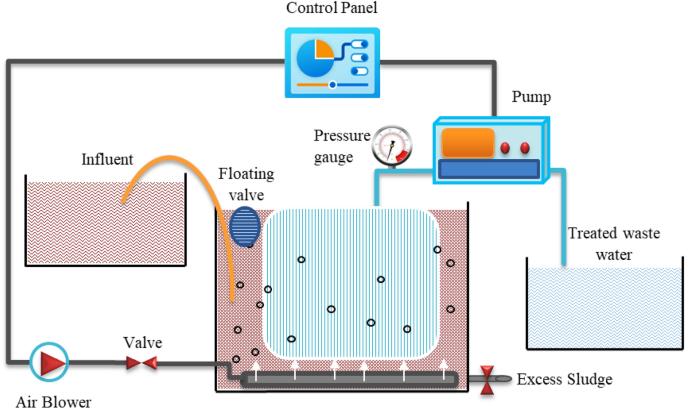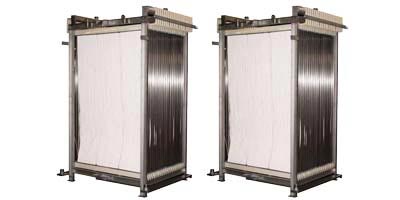The Role of Membrane Bioreactor in Achieving Higher Effluent Quality Standards
The Role of Membrane Bioreactor in Achieving Higher Effluent Quality Standards
Blog Article
Just How Membrane Layer Bioreactors Are Changing Water Filtration Equipments
The appearance of membrane layer bioreactors (MBRs) represents a substantial advancement in the field of water purification, combining organic therapy processes with sophisticated membrane filtering technologies. This integration not just boosts the quality of dealt with effluent however likewise addresses metropolitan space restraints, making MBRs especially suitable for densely inhabited locations. As international water deficiency increases, the role of MBRs in helping with drinkable water reuse and lasting water monitoring ends up being progressively essential. The ramifications of this modern technology expand beyond effectiveness-- what obstacles and possibilities exist in advance for its widespread implementation?
Review of Membrane Bioreactors
Membrane bioreactors (MBRs) stand for a significant development in water purification modern technology, as they combine biological therapy procedures with membrane layer filtering. This combination boosts the efficiency of wastewater treatment by using microbes to degrade organic pollutants while all at once employing semi-permeable membrane layers to different treated water from suspended microorganisms and solids.
The MBR system typically includes a biological reactor where the microbial population metabolizes contaminants, complied with by a membrane layer filtration system that preserves biomass and permits only clean water to go through. This dual capability leads to greater effluent top quality contrasted to standard treatment methods. MBRs can be operated in both set and constant circulation modes, supplying flexibility in layout and application.
Furthermore, MBRs are characterized by their small impact, making them suitable for urban settings with room restraints. Membrane Bioreactor. They additionally allow the healing of water for reuse, thus adding to water sustainability initiatives. While MBR technology has actually gotten popularity in metropolitan and commercial applications, its operational complexities and power needs demand mindful factor to consider throughout implementation. Generally, MBRs go to the leading edge of improving water therapy effectiveness and top quality, showcasing the capacity for ingenious solutions in ecological monitoring.
Benefits of MBR Innovation
The combination of biological treatment with membrane filtration supplies many advantages for water filtration procedures. Among the key benefits of Membrane Bioreactor (MBR) technology is its capacity to effectively get rid of both natural and not natural pollutants, bring about top quality effluent. The membrane layers serve as a physical barrier, avoiding put on hold solids and pathogens from going through, which enhances the general safety and dependability of cured water.
Additionally, MBR systems require a smaller sized impact compared to traditional therapy techniques, permitting for more effective room use. This portable design is particularly helpful in urban settings where land is restricted. MBRs also demonstrate functional versatility, fitting differing influent qualities and circulation rates without substantial performance deterioration.
Furthermore, the procedure offers enhanced nutrient elimination capabilities, particularly for nitrogen and phosphorus, which are crucial for avoiding eutrophication in getting waters. The lowered sludge production related to MBR innovation also equates to reduce disposal expenses, making it an affordable service in the future - Membrane Bioreactor. In general, the benefits of MBR modern technology placement it as a leading option for cutting-edge and lasting water purification systems, addressing both ecological and economic problems
Applications in Water Filtration
Applications of Membrane Layer Bioreactor (MBR) innovation in water filtration are impactful and diverse, addressing various treatment requires across multiple sectors. MBRs efficiently combine biological treatment procedures with membrane layer filtering, making them perfect for community wastewater therapy, commercial effluent monitoring, and even safe and clean water reuse initiatives.
In metropolitan settings, MBRs are significantly employed to enhance the high Continued quality of dealt with wastewater, permitting conformity with rigorous discharge guidelines and assisting in the recycling of water for irrigation and non-potable usages. Their portable layout also makes them suitable for urban settings where area is limited.
Industrially, MBR innovation is utilized to treat process water and wastewater, specifically in fields such as food and drink, pharmaceuticals, and fabrics. By effectively removing contaminants and suspended solids, MBRs help markets decrease ecological impacts while recuperating useful sources from wastewater streams.
Additionally, MBRs are getting traction in decentralized water therapy applications, where small-scale systems can be deployed in remote areas or developing regions. This adaptability enables neighborhoods to attain sustainable water management options, enhancing accessibility to clean water while lowering reliance on standard treatment techniques.
Case Researches and Success Stories

In one more instance, a fabric manufacturing facility in Bangladesh embraced MBR modern technology to address its wastewater difficulties. The system reduced chemical oxygen demand (COD) levels from 1,200 mg/L to less than 100 mg/L, thus satisfying regulatory requirements and substantially minimizing environmental effect.
The College of Cape Community's MBR installment has actually verified reliable in treating greywater for non-potable reuse on school. This task not only conserves potable water however additionally functions as an academic design you could try here for sustainable methods.
Moreover, a seafood handling plant in Norway utilized MBR technology to deal with effluents consisting of high degrees of natural issue, accomplishing over 90% pollutant elimination. These instance research studies emphasize MBR modern technology's convenience and its vital role in enhancing water top quality throughout diverse applications.
Future of Water Treatment Solutions
As international water deficiency and air pollution challenges magnify, cutting-edge water treatment services are becoming significantly vital to guarantee sustainable access to clean water. The future of water treatment hinges on the integration of innovative technologies that boost the effectiveness and efficiency of purification procedures. Membrane layer bioreactors (MBRs) go to the center of this evolution, integrating biological therapy with membrane filtration to generate premium effluent ideal for different applications.

Emerging fads such as resource healing from wastewater, consisting of nutrients and power, will certainly even more change therapy centers into eco-friendly hubs. Furthermore, developments in nanotechnology and membrane layer materials assure improved efficiency and durability of filtering systems.

Final Thought
To conclude, membrane layer bioreactors represent a considerable development in water purification technologies, successfully combining organic therapy with innovative membrane filtration. The numerous advantages, including boosted effluent high quality and decreased spatial needs, make MBRs particularly ideal for metropolitan applications. Their role in safe and clean water reuse and lasting water management highlights their relevance in addressing worldwide water scarcity difficulties. Continued r & d will better enhance the effectiveness and adoption of MBR technology, ensuring a resistant future for water therapy options.
The introduction of membrane layer bioreactors (MBRs) represents a significant advancement in the area of water filtration, merging biological therapy procedures with sophisticated membrane layer filtration technologies. As international water scarcity escalates, the duty of MBRs in facilitating drinkable water reuse and sustainable water management becomes progressively critical. They likewise allow article source the recuperation of water for reuse, hence contributing to water sustainability initiatives.As international water deficiency and pollution challenges magnify, ingenious water therapy options are ending up being progressively important to guarantee sustainable accessibility to tidy water. Their role in safe and clean water reuse and sustainable water management highlights their value in dealing with global water deficiency difficulties.
Report this page